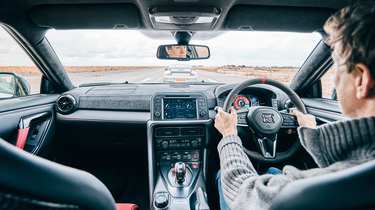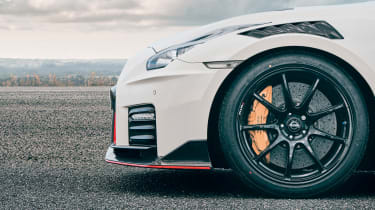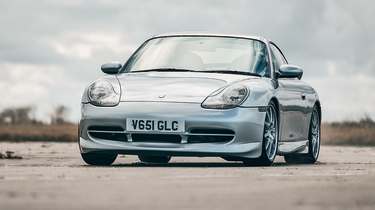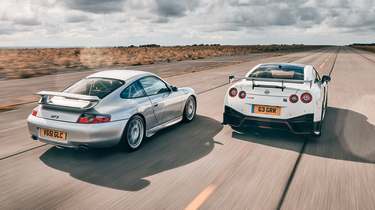Nissan GT‑R v Porsche 911 GT3 (996) – landmark super-sports cars go head-to-head
Porsche v Nissan was a head-to-head no one would have predicted at evo's launch, but then those two marques created the two most significant super-sports cars of the last 25 years
Two entirely different cars: one from the beginning of a dynasty, one at its culmination. One manual, rear-driven and with the bare minimum of electronics; one all-wheel drive and all about technology. Both have become ever-present landmarks, both in the evo story and the wider evolution of the performance car.
When this magazine came into being, the Nissan GT‑R was in its fourth, R33 generation and still called the Skyline. The musclebound R34 came along in 1999 but it was the R35 generation that arrived in 2008, dropped the Skyline label and became simply the GT‑R, that picked up the performance car goalposts and set them down in a whole new playing field. Fifteen years ago. A long time. Yet the R35 only retired from sale in the European market in 2022 (largely due to EU and UK drive-by noise regulations) and it’s still on sale in Japan and the US. It’s been a unique yardstick for performance and sheer ability in three separate decades.
> R35 Nissan GT-R (2009-2022) review – a technical triumph that may never be repeated
During that time, the GT‑R has featured on umpteen evo covers, either starring as the main car or, frequently, a must-have component in a group test. Contributing editors Jethro Bovingdon and Henry Catchpole both voted the R35 in their top five: ‘When it came out it was this one car that did everything,’ says Henry. ‘We put it up against everything, and it was an ultimate all-rounder in a way.’ Ultimate enough to win evo Car of the Year in 2008, against Lamborghini’s Gallardo LP560‑4 and Porsche’s 997-gen 911 GT2. Back then the GT‑R cost little more than £50k, and an initially bargainous performance-to-pound ratio was an intrinsic part of both its appeal and its confounding nature.
Here was a car that was heavy – more than 1700kg – and big at more than 4.7m long and 1.3m tall, yet could out-grip, outpace and lap faster than more or less any six-figure supercar, in any weather. And be a completely involving, immersive experience for the driver while doing so. ‘There has always been this criticism – probably started in trackday pitlanes by 997 owners who had just been overtaken – that it’s a “PlayStation car”, which it never was,’ Henry says. ‘That suggests something uninvolving and a bit remote, which it just wasn’t. You could get a lot of speed out of it, but to drive it toward its limits you had to really think and almost override your instincts. You had to understand how its clever four-wheel-drive system wanted to do things – sort of like a Mitsubishi Evo in some ways, but bigger, more potent.’
‘I remember driving it for the very first time and it made cars like R8 V10s and 911 Turbos feel somehow instantly antiquated,’ says Jethro. ‘That didn’t mean it made them bad, because they still had some qualities that the Nissan lacked, and still do. But at the time this thing had completely fast-forwarded what performance cars were capable of. I remember watching the boost gauge sit at maximum boost while changing gear, how big a difference that dual-clutch ’box made to the accessibility of performance, and the level of grip and agility for such a big car.
‘It was the first really big, heavy car to completely defy your expectations. Very few cars have done it since and it’s only now that we’re in that space, with the BMW M5 CS and various other M cars and Porsches. They’ve got heavier and heavier but, dynamically, they still retain that lightweight agility we all crave. The Nissan was the first car to do that. It’s so fast, so competent, so aggressive in the way it changes direction. It just completely rewrote what was possible.’
Over time, the price crept up, 2022-model-year R35s costing more than £80k by the time sales closed in the UK. Priciest factory-spec GT‑R of all, however (leaving the many wild tuner creations that are an equally big part of the GT‑R story out of the equation) was the rare, specialised Nismo. Introduced in 2013, like the rest of the R35 range it received iterative updates each year, many of which centred on weight-saving, aerodynamics, expensive dampers and powertrain enhancements. Only a handful of GT‑R Nismos made it to the UK each year. Pictured here is the final version to be offered in the UK, sold in limited numbers in 2022, at a price exceeding £180k.
It was quite a way to close the R35’s UK story. Driving the Nismo today, it strikes me it’s the first time I’ve driven one when it’s not raining. I have vivid memories of driving the 2017 version around a slippery Silverstone and an equally sodden ribbon of road in north Wales. One wide and snooker-table smooth, the other with barely enough room for the car. It was mind-blowing in both settings, eking out grip where instinct said there should be none and doing remarkable things with its damping.
Today, in Indian summer sunshine, it’s as mind-alteringly, expectation-confoundingly, perception-redefiningly good as I recall. The experience is a strange mixture of enjoying the surprising delicacy and directness of the steering, and withstanding the sheer pulverising cornering forces at work. The GT‑R digs into the tarmac, grasping and finding grip like a rock climber getting a handhold, and summons ridiculous traction. Yet it feels playful, malleable too. It’s truly tactile and exciting, and unique in feel.
It’s a car of contrasts: enormous in size, heavy in weight, yet nimble; brutal yet delicate; and you sit in a lofty driving position under a high roof, yet feel hunkered down to the road. Computerised yet mechanical: you hear all kinds of almost agricultural sounds from the transmission and differentials, and feel them winding up as you manoeuvre at parking speeds. It’s anything but digital.
Leaving aside the uniqueness of its driving experience, the R35 is a significant car in terms of its wider impact. The GT‑R’s otherworldly abilities on road and track (whether in drag races or around a damp Nordschleife) prompted head-scratching and drawing board revisitations at various manufacturers – and an increased amount of attention paid to lap times around that aforementioned circuit. ‘In the context of the GT‑R’s significance as a whole, it was both a positive and negative thing,’ ponders Henry, ‘because I’m sure it made everyone else think, “Right, we have to focus on performance, we can’t have this car from Japan that weighs a lot and looks massive outperform us.” I can imagine it stimulated development of dual-clutch transmissions and turbos, and influenced that direction of travel.’
Jethro adds: ‘It’s significant above and beyond its driving experience, and not necessarily for the good of performance cars, because what it did was make Porsche, Ferrari, everyone, chase this incredible efficiency of performance. And I think the 997.2 Turbo was the first time you saw that – Porsche chasing down another car rather than setting their own benchmark. And since then, what we’ve seen is more power, more grip, more accessibility, dual-clutch ’boxes, twin turbos – it just set a blueprint for the future.
‘You could very well argue it was where the performance car branched off, or pivoted, to this new direction we have now – and that we moan about – where performance is king, and things like low mass and so on have sort of been swept aside. So, arguably, the R35 is both a good and a bad car for its significance.’
What’s next for the GT‑R story? Journalists have been asking questions about what the R36 has in store in three separate decades now, but the answer has always been: ‘Not yet.’ Creating another game-changer isn’t easy. Perhaps an all-electric GT‑R will confound the world’s expectations once more, but it won’t be along any time soon.
Meanwhile, Jethro sums up the R35 like this: ‘A fantastic driving experience, and a unique one, and that’s what we should celebrate: cars that are unique. There are so many things that have the same chassis, same engine, the same dimensions almost. The GT‑R is a one-off, in and of itself. Much maligned, but I think they’re fantastic.’
If the GT‑R is maligned in some quarters, the Porsche 911 GT3 is almost universally eulogised. Virtually every evo contributor who voted in this countdown nominated a 911 GT3 of one kind or another. But this is the first one, where it all began: 1999’s 996 GT3.
The 996-generation Porsche 911 in general has a strong link with evo: it was born only a short time before this magazine first appeared, and the regular 996 Carrera won the very first eCoty in 1998. It has also featured in a fair few Fast Fleet entries… But the GT3 was something special. If arch Porsche fans were still rankled by the fried-egg headlights (softened visually by clear indicator lenses on the GT3), smoothly hipless bodyshell and water-cooled engine, this raw road-racer was swiftly taken to their hearts – and those of people not normally enamoured by Porsches, too.
The GT3 was more than just a nameplate; it was so-called because it was created as a homologation car for the then-new GT3 racing formula, which was based around more production-spec cars than the category of the same name today. (Incidentally, the Nissan R35 GT‑R has also had a glittering career in GT3 racing, winning races against much smaller, lither opposition – racing life imitating road-going art. The Nismo uses the same turbochargers as the race car among its money-almost-no-object component count.)
From its 18-inch split rims to its Salvador Dali-esque rear spoiler, the 911 GT3 was a car built for driving, and with real motorsport genes. The 911 Carrera’s sound deadening and extraneous equipment were summarily dismissed, although famously the 1350kg GT3 was considered to weigh a little more than the base 996 Carrera, owing to its bigger brakes, wheels and wing and its use of the stiffer Carrera 4 body. (As ever with kerb weight figures, the real picture is murky; Andreas Preuninger says the way Porsche’s GT department records kerb weights is a little different to the wider company’s approach. The only surefire way to see if a 996 GT3 is heavier than a Carrera is to stick them both on the same set of scales.)
The Carrera’s 3.4-litre engine was switched for the now-fabled 3.6-litre powerplant known as the ‘Mezger engine’ in deference to being based on the race engine designed by feted Porsche engineer Hans Mezger. The GT3’s lump shares DNA with both the 911 GT1 ’98 Le Mans car and the 959 of the ’80s, with regards to its dry sump and cylinder heads respectively, and it raised the red line to 7600rpm compared with the 996 Carrera’s 7200rpm limit. It would go on to be used in all 997-generation GT3s (and versions of the 996 and 997 Turbo too), culminating in 2011’s bored-out 997 GT3 RS 4.0.
Back to the beginning, and the here and now. This lovely 55,000-mile Arctic Silver car kindly loaned by Porsche specialist Paragon in Sussex looks tiny, petite, next to the hulking Nissan – and next to a present-day 911, for that matter. You sit in one-piece buckets (standard on Clubsport-spec cars and an option for ‘Comfort’ examples like this one, as was the half roll-cage over the absent rear seats), adjust the door mirrors with stalks rather than buttons, and hold an equally button-free three-spoke steering wheel (with a big, ’90s-spec airbag housing in the middle). This particular car’s original owner also ticked the delete box for the centre console storage, an absence that would be a drawback in most cars but somehow makes the GT3 all the more desirable, fitting in with the homologation vibe.
No turbos here, GT3 racing-derived or otherwise, and the 911 GT3 has remained naturally aspirated ever since. As in many of the all-time-great 911s, the Mezger engine sounds slightly rough at idle, like a gently shaken cutlery drawer, then clears its throat into a sweet, serrated howl at higher revs.
The 996 GT3’s nose bobs up and down in the manner of classic 911s, and the steering is very chatty, the wheel writhing gently in your hands; later 911s filter a little more of that movement out. And add an extra turn of pace: the original GT3 doesn’t feel all that fast any more in a straight line. Which matters not a bit, because it’s all about feel. The steering, the pedals, the short-throw six-speed gearchange, the feedback through the bucket seats and the seat of your pants, and the cacophony of sounds in your eardrums: it makes a glorious noise.
And, even with the deleted console and tinnier-than-average radio, it has all of the ergonomics and much of the usability of a regular modern-era 911. You can certainly see how the recipe has come to work so well.
This car opened up a new division and product line at Porsche: the aforementioned GT department, which works closely with the company’s motorsport arm and from which has since sprung multiple generations of 911 GT3 and GT2 families and their many variants, the 911 R and Speedster, Cayman GT4 and Boxster Spyder and more besides.
The director of the GT department almost since its beginning has been Andreas ‘Mr GT3’ Preuninger. The 996 GT3 was already in production when he joined; his first project was its ‘996.2’ update in 2003. ‘The 996 GT3 was the nucleus of everything,’ he says. ‘It was more or less a side-project of Roland Kussmaul [the famous Porsche racing engineer with Dakar and Le Mans programmes and the 964 RS on his CV]; he had five, six, maybe ten people at times within the motorsport sales department to work on the car. It was not a specific department. Only when the second generation came in, which I had the pleasure to lead – everything went from there.’
Under Preuninger’s direction the 996.2 GT3 added a straighter, less lava lamp-esque (but less visually interesting) rear wing, prettier headlights in a facelifted front end, a 21bhp power increase to 376bhp, better brakes, revised rear suspension and a stiffer body among other changes, but the purity of the 996.1, and its position in history as the very beginning of the 911 GT3 story, makes it something really quite special.
The GT3 generations descended from it since have become a high-water mark for driver’s cars – and, for better or worse, as much a part of the investment market as stocks, shares, art and fine wine, with gravity-defying depreciation curves. ‘The GT department, it’s like an island in Porsche, or a castle with a moat around it,’ Andreas Preuninger says. ‘Sometimes we have to defend it – we can see an attack when it’s on the water! – but we can do whatever we want to do, as long as it works.’
The 996 GT3 and its descendants would suggest the policy has been working pretty well. With every update, successive models would get faster, grippier, cleverer, sharper in response, but they’ve always hung on to their naturally aspirated, two-wheel-drive, organic roots – all exhibited to great effect by the car on these pages.
Only 106 996.1 GT3s were brought to the UK. Paragon MD Mark Sumpter reckons there are perhaps 55 to 60 good cars remaining today. Even more than usual, I wish I had a spare £84,995, the asking price for this particular car.
GT3 and GT‑R: two entirely different cars from two entirely different car companies. There’s nothing quite like either of them. Both unforgettable once driven, and both part of a lineage of cars that have changed our world.
With thanks to Paragon Porsche (paragongb.com). This story was first featured in evo issue 315.










